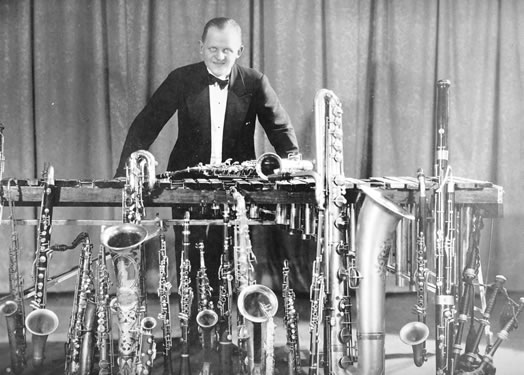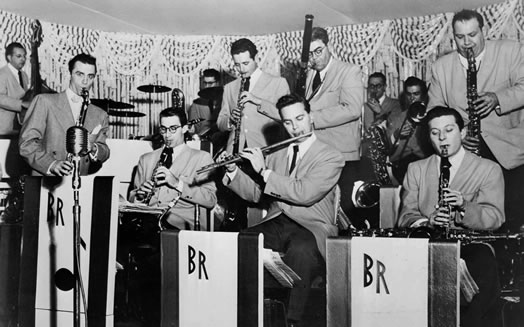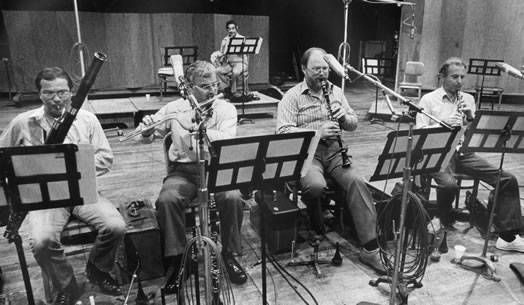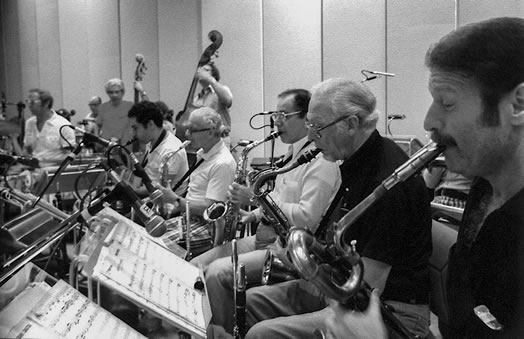Allegro
The Evolution of Doubling
Volume 116, No. 12December, 2016
For most woodwind players on Broadway, doubling is a mandatory part of the profession. But was this always true…and how old is the tradition of doubling?

Check out that woodwind collection – now that’s doubling! Ross Gorman (above) was one of the wind doublers in Paul Whiteman’s orchestra and was the clarinetist who initially performed the famous opening of Gershwin’s “Rhapsody in Blue.” Photo courtesy of Sheila Gorman.
Multi-tasking has become a staple of modern living and is certainly a requirement for surviving in today’s music industry. The contemporary saxophone doubler represents the greatest example of this characteristic in music. While most people believe that the origins of this discipline occurred with the Paul Whiteman Orchestras of the 1920s, woodwind multiple instrumental performance dates back several centuries.
In 16th century Vienna, consorts of wind instruments were used for ceremonial occasions, processions, and dances. The musicians changed from one instrument to another to avoid monotony of tone color and to accommodate a variety of musical forms. In 17th century France, composers such as Lully included pairs of oboes in his works that were to be played by other woodwind players. In Germany during the 17th and 18th centuries, municipalities employed gifted town multi-instrumental musicians known as “Stadtpfeifers” to perform all functions that involved music. Several generations of J.S. Bach’s family belonged to this profession and J.S. himself was destined for this career had he not decided on following in his older brother’s footsteps to become a church organist. Imagine what would have happened if Bach had become a wind multi-wind instrumentalist instead of a virtuoso organist and subsequently an ingenious composer? In this case, we are all lucky that he did not become a doubler!
During the Baroque era, the finest European orchestras displayed a penchant for using woodwind doublers. This allowed bassoonists and oboists (the dominant instrumentalists of the time) to play flutes and clarinets as well. The great Mannheim Orchestra of the 18th century employed oboists who doubled on flute and clarinet. Several works by Haydn and Mozart were conceived with doublers in mind when they required their oboists to switch to flutes or clarinets within the same piece. (For example, see Haydn symphonies #9 and #24, and Mozart symphonies #6, #9, #12 and #24.)

The sax/woodwind section in Boyd Raeburn’s band featured many doublers. Photo courtesy of Bruce Raeburn.
The origins of the contemporary woodwind doubler can be traced to the development of the saxophone. Adolphe Sax, a virtuoso flute and clarinet player, created an instrument that would strengthen the woodwind sections in the French military bands in the mid-19th century. As a result, the saxophone became a prominent military band instrument in Europe during the 1850s and the first accomplished saxophonists were those originally trained as clarinetists. While 19th century composers such as Bizet, Berlioz, Massenet, Thomas and d’Indy incorporated the saxophone in orchestral works, the new instrument made its first significant impact in America in the late 19th and early 20th centuries as a member of circus and minstrel shows, wind bands, dance bands and Vaudeville pit bands. The wind bands of Patrick Gilmore and John Philip Sousa were particularly important in elevating the visibility of their sax sections. However, the popularity that the saxophone experienced in the U.S. in the 1910s to 1930s, which ultimately led to the evolution of the saxophone doubler, can largely be attributed to the success of Rudy Wiedoeft, the Six Brown Brothers and Paul Whiteman.
Wiedoeft recorded with all of the major labels of the time on his C-melody saxophone. The artistry and virtuosity he demonstrated while performing original works and classical transcriptions inspired a new generation of saxophone soloists including Coleman Hawkins, Jimmy Dorsey, Clyde Doerr, Don Redman, Al Gallodoro, Frankie Trumbauer, Chester Hazlett, Rudy Vallee and Andy Sannella, among many others. The Six Brown Brothers, a Canadian Vaudeville sax section act that combined musical comedy and showmanship in their performances, maintained a level of ensemble playing that was spectacular throughout their career. They starred in a Broadway show, a short film and toured throughout the world – all while becoming the highest paid musical act in Vaudeville. Paul Whiteman had the most influence on the American cultural sensibility in the decade following the end of World War I. The popularity of his orchestra and the prominent role of his original three-man saxophone doubling section – Ross Gorman (see photo on page 22), Hale Byers, Donald Clark – contributed to the saxophone becoming the most widely sold woodwind in the 1920s, a period known as the golden age for saxophones in America.
While Whiteman’s doubling sections covered all of the woodwinds, most 1920s dance bands and jazz bands did not employ the large array of instruments displayed by Whiteman’s reed players. The most typical woodwind instrumentation of these bands consisted of three saxophonists (either two altos plus a tenor, or alto, tenor and baritone), all of whom doubled on clarinet. This can be best heard in the recordings of the Fletcher Henderson Band and Duke Ellington Orchestra of this period. Their legendary saxophonists – including Coleman Hawkins, Don Redman, Buster Bailey, Hilton Jefferson, Russell Procope, Benny Carter, Johnny Hodges, Barney Bigard and Harry Carney – all played clarinet.

The L.A. Saxes in 1979. Photo courtesy of Joe Soldo.
In the early 1920s, over 50 percent of the motion pictures released were Hollywood “silents.” Saxophone/clarinet doublers gained steady work and attained greater visibility while playing the music that accompanied these in the theaters. When movie soundtracks began to be used in 1927, the doublers now found work in the studios, recording the music for synchronized sound films. In addition, animated cartoons created an additional need for woodwind multi-instrumentalists in the production studios of MGM, Paramount, RKO, Warner Bros., Columbia, 20th Century Fox, United Artists and Universal.
Radio became the most significant new form of communication in the 1920s through live performances or audio recordings. Radio jobs became a very desirable means of earning a living for many musicians from that point forward. The star players also became part of the network’s staff orchestra, which often included a group of woodwind doublers who were responsible for rendering diverse musical stylings – from classical to jazz – as well as commercial spots.
Prior to 1927, Broadway musicals typically employed the standard orchestral woodwinds, often in pairs – two clarinets; two flutes; oboe/English horn; and bassoon. However, beginning with Rodgers and Hart’s “A Connecticut Yankee” in 1927, doubling chairs began to appear – Reed III played clarinet and flute; Reed V played clarinet and bassoon. Saxophone initially appeared on Broadway in Jerome Kern’s 1913 show “Oh, I Say,” and highly skilled orchestrators such as Robert Russell Bennett, Hans Spialek, Ted Vodery and Frank Saddler utilized saxophone in their scores in the 1920s. However, it wasn’t until the 1930s that saxophone doubling became a more accepted norm in the musical theater. Two Gershwin musicals that became hit shows in 1930 – “Girl Crazy” and “Strike Up The Band” – included saxophone-doubling chairs. In fact, Benny Goodman played clarinet and saxophone on “Girl Crazy” and Jimmy Dorsey did likewise on “Strike Up The Band.” Cole Porter’s “Anything Goes” (1934), orchestrated by Spialek and Bennett, firmly established the use of doubling in musical theater. The chairs were:
Reed I – alto sax, clarinet, flute
Reed II – alto sax, clarinet, oboe, English horn
Reed III – tenor sax, clarinet, bass clarinet
Some of the saxophone artists who initially established themselves during the early days of commercial woodwind doubling in New York between 1930 and 1950 included Jimmy Abato, Joe Allard, Sal Amato, Arnold Brillhart, Garvin Bushell, Sid Cooper, Artie Drellinger, Al Gallodoro, Teddy Gompers, Chester Hazlitt, Merle Johnson, Bernie Kaufman, Toots Mondello, Eddie Powell, Paul Ricci, Bill Shiner and Stanley Webb.
This trend towards saxophone doubling also infused itself in the most successful society bands of this period led by Eddie Duchin, Meyer Davis, Lester Lanin, Raymond Scott and Ben Selvin. They worked constantly and provided regular work and financial stability for their first-call players.
The Golden Age of woodwind doubling began to emerge during the post-WW II period. This coincided with the disappearance of the radio orchestras and the advent of television as the new medium for entertainment. Many new TV shows were modeled on old time radio variety shows and created steady work for commercial woodwind multi-instrumentalists – The Bell Telephone Hour, Your Show of Shows, The Tonight Show, The Ed Sullivan Show, The Milton Berle Show, etc. Also during this period, woodwind doubling reached an extremely high level in two bands: the Boyd Raeburn Band (see photo above) and the Sauter/Finegan Band. The Raeburn band’s principal orchestrators were George Handy and Johnny Richards and they wrote demanding, virtuosic parts for their saxophones while requiring them to play all of the orchestral woodwinds. Two of the Swing Era’s greatest orchestrators – Eddie Sauter and Bill Finegan – employed a five-person reed section that played all the major woodwinds in their ensemble during the band’s most active period, 1952 to 1955. The chairs were:
Reed I: alto sax, tenor sax, flute, piccolo, clarinet, tenor recorder
Reed II: alto sax, tenor sax, flute, piccolo, clarinet, bass recorder
Reed III: tenor sax, clarinet, flute, oboe, English horn
Reed IV: baritone sax, tenor sax, clarinet, bass clarinet, flute, bassoon
Reed V: baritone sax, alto sax, clarinet, bass clarinet, bassoon
In New York during the vibrant period of the 1950s to 1970s, television staff orchestras, hotel bands, society bands, and musical theater orchestras provided a great amount of work for saxophone doublers. In addition, the elite freelance musicians would average a dozen or more record and jingle dates per week. Many players turned to woodwind doubling because of the lucrative incomes many of the players were making. The evolution of the jingle industry during this period provides a view of why doublers were so in demand. Commercials were often several minutes long in the early days of television. Music written for commercial advertisements occupied most of the time since there might not be any talking until the very end of the spot. The fact that there was so much music necessitated a greater variety of musical styles and instrumental colors in order to keep the listener’s attention. Also, since music was often the last item in the commercial production to be addressed, composers and arrangers had to work quickly and were often undecided about what woodwinds or combinations to use. Employing competent doublers allowed them to make these decisions on a last-minute basis. Sax doublers were typically asked to bring a variety of instruments to these dates and were paid whether they used them or not. The generation of remarkable New York-based studio saxophone doublers that emerged during this period included Don Ashworth, Danny Bank, Ray Beckenstein, Al Block, Phil Bodner, John Campo, Eddie Caine, Eddie Daniels, Lew Del Gatto, Harvey Estrin, Hank Freeman, Ron Jannelli, Sid Jekowsky, Wally Kane, Al Klink, Walt Levinsky, George Marge, Tommy Newsom, Romeo Penque, Al Regni, Jerome Richardson, Jerry Sanfino, Les Scott, Joe Soldo, Bob Steen, Dave Tofani and Bob Tricarico.

The Sinatra Saxes, pictured in 1980. Photo courtesy of Teddy Sommer.
In Los Angeles, work for doublers also multiplied after World War II. Many of the big band saxophonists such as Gus Bivona, Gene Cipriano, Buddy Collette, Bud Cooper, Harry Klee, Justin Gordon, Plas Johnson, Ronnie Lang, Ted Nash, Dave Pell, Les Robinson, Ethmer Roten, Willie Schwartz, Bud Shank and Champ Webb settled in L.A. to take advantage of the expanding work scene. All of the major motion picture studios had contracted staff orchestras with doublers in the 1940s and 1950s. Movie studios also began to extend their influence into radio and television. The popularity of the weekly television shows began a trend for the hiring of woodwind doublers since the musical scoring called for smaller, more versatile bands than you would expect on a movie set. Henry Mancini’s success with two television series – “Peter Gunn” (1957) and “Mr. Lucky” (1959) – established the use of flutes, oboes, bassoons, clarinets and saxes as a requirement for TV scoring. These Hollywood studio musicians were highly regarded by the composers, orchestrators and conductors who worked with them on a daily basis and they were well rewarded financially.
By 1960, however, the Hollywood studio orchestras had disappeared. But with the creation of more L.A.-based television shows; the continuation of movie soundtrack recording now on a freelance basis; and the creation of state-of-the-art recording studios that attracted record labels, L.A. doublers found themselves with even more available work and better pay. Those saxophonists who played the orchestral woodwinds at a very high level found themselves with more work than they could handle, and many New York doublers relocated to the West Coast in the 1960s and 1970s to take advantage of this situation. Gene Cipriano, perhaps the most recorded saxophone doubler in history and still going strong today at 88, told me that when he arrived in L.A. in the 1950s there were no oboe doublers who played flute capably. As a result, he couldn’t get a sub from 1958 to 1965 for many of his jobs!
It should be noted that there have also been a number of jazz saxophonists, not necessarily associated with commercial woodwind doubling, who have distinguished themselves as wonderful multi-instrumentalists. They represent some of the greatest improvisers in history – Sidney Bechet, Nick Brignola, Benny Carter, Jerry Dodgion, Eric Dolphy, Jimmy Dorsey, Rahsaan Roland Kirk, Sam Most, Art Pepper, Ira Sullivan, Lew Tabackin and Frank Wess.
New York and Los Angeles were not the only towns that afforded doublers a great deal of work after WW II. The Las Vegas hotels and casinos employed large bands at each venue and offered year-round employment from 1957 to 1987. There was so much work there for capable doublers that many held two or three jobs simultaneously. Nashville, Detroit, Chicago, Memphis, Dallas and Toronto also became major recording venues. But this burgeoning area of the industry began to change with the increasing popularity of rock-and-roll in the 1960s.
While the typical recording sessions of popular music between 1945 and 1965 had employed sections of 4 to 5 doubling saxophonists, the pop music of the Beatles/Motown era now called for much smaller horn sections. One or maybe two saxophonists were used on these recordings and were not necessarily called upon to double. This ultimately led to the popularity of the rock saxophone soloist starting around 1960 and continuing to the present. Some of the more in-demand saxophonists for this style of music have been King Curtis, Mike Brecker, Clarence Cleamons, Maceo Parker, Lenny Pickett, Dave Sanborn, Buddy Savitt, Tom Scott, Stanley Turrentine and Grover Washington. While there was still a need for saxophone soloists who could double very well for record dates, jingles, movie and TV soundtracks into the 1980s, the overall quantity of work had begun to decline. Those successful saxophone-doubling soloists in the modern era have included Eddie Daniels, Joe Farrell, Lawrence Feldman, Gary Foster, Dan Higgins, Sal Lozano, Lou Marini, Bob Mintzer, Dave Tofani and George Young. However, with the changing culture of pop music and the advent of synthesizers, the handwriting was on the wall for the work possibilities in the future for multiple woodwind instrumentalists.
The movie industry also underwent changes from 1975 to 2000, and Hollywood films started to emphasize some of the traditional European orchestral instrumentations, without doublers. Legendary composers like John Williams and Jerry Goldsmith gradually eliminated the use of woodwind doubling sections in their scores. Instead, they might make use a highly sophisticated L.A. doubler like Gary Foster or Dan Higgins to play a 3rd flute part and add a sax solo. In fact, many soundtracks were now being recorded in non-union venues such as Vancouver, Seattle, Salt Lake City, London, Poland and the Czech Republic, so work in this sector of the industry fell dramatically. And the use of synthesizers in lieu of any acoustic instruments in the Academy Award winning film “Chariots of Fire” (1981), was the harbinger of things to come for a period of time.
Society bands and club dates, which always made use of saxophone doublers into the 1990s, also experienced a face-lift. No longer were there big bands of musicians capable of playing a six-hour job without any music, with every musician capable of not only playing the melody to thousand of tunes in any key, but also with the ability to fake any harmony part in support of that melody and improvise very well – amazing! Large and small bands alike were replaced by DJs and more recently by library music that people have downloaded onto their iPhones and plug into a sound system at the affair.
Broadway continued to make use of large number of doublers in musical productions into the new millennium. During the 1980s, a saxophone doubling section with a minimum of three players made up 71 percent of the musicals running. However, that number has continued to decrease. In the 1990s, 40 percent of the musicals maintained a saxophone doubling section of three or more; and the first decade of the millennium saw that average shrink to 35 percent. As of Labor Day 2016, 23 percent of the musicals running had woodwind sections consisting of three or more saxophone doublers with a grand total of 33 saxophone-doubling chairs in the 22 musicals. These jobs and the touring companies that these musicals generate remain the largest source of income and job possibility for any commercial saxophone doubler today.
While it is hard to know exactly what career possibilities will exist in the future for the dedicated saxophone doubler, one thing remains clear – there has been an illustrious history of superb music making by saxophone multi-instrumentalists and it is incumbent upon anyone attempting to enter this highly specialized field to learn about them and spend time listening to their recordings while trying to carry forward their legacy.
Woodwind player Ed Joffe has been a member of Local 802 since 1972. This article is excerpted from his publication “Woodwind Doubling for Saxophone, Clarinet & Flute” at Joffewoodwinds.com.
